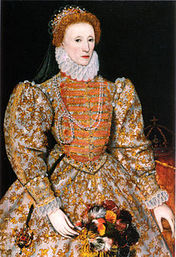|
Before I embark on June's Blog & following an excellent talk given by Clive Hallam-Baker at the Bygone Borderlands weekend in Berwick on the "Role of Women at Flodden", I thought I would re-visit my previous post on this very subject. In addition to the women mentioned in my previous post, Mr Hallam-Baker highlighted the role played by women (and children) on the battlefield itself. It would appear that far from staying at home, many women accompanied their husbands on the march North. Some maybe to ensure their husbands did not "sow any wild oats" along the way, others to help with the logistics of feeding and caring for such a large army. Another important role undertaken by women was the care of the sick & wounded, the knowledge of healing herbs & medicines of the day being passed down the generations from mother to daughter. Unfortunately in later years many of these "wise women" would be branded witches and suffer some form of farcical trial & hideous death. Children on the other hand acted as "water boys". Hand to hand fighting in heavy and cumbersome armour was hot & thirsty work!. Mr Hallam-Baker is of the opinion that during the battle there would be periods of armistice to allow the children to enter the field with water for the troops. Rather like the early days of trench warfare in WW1 where boards went up and the fighting stopped for breakfast. The last women to be highlighted by Mr Hallam-Baker are unique in that they are all Queens in their own right. Okay, two had token husbands, but one had no husband at all! They all died childless. Following the death of Henry VIII's son Edward, England would be ruled for the next 50 years by women:- Firstly in an attempt to maintain the continuation of the Protestant faith in July 1553 by the manipulated and ill-fated Jane Grey, granddaughter of Henry's youngest sister Mary by her second marriage to Charles Brandon. Secondly by Henry's daughter Mary, daughter of his first marriage to Catherine of Aragon, hell bent on restoring the Catholic faith to England from July 1553 until her death in 1558. Her persecution of the Protestants led her to be dubbed "Bloody Mary". Thirdly by Elizabeth, who reigned for 44 years from 1558 -1603. Daughter of Henry's second marriage to Anne Boleyn, she was more moderate in government than her half siblings, and more tolerant in matters of religion. There is of course one other woman deserving a mention here who proved to be a constant "thorn in the side" to the Tudor Dynasty. Another Queen, of Tudor descent, being granddaughter of Henry VIII's eldest sister Margaret & James IV of Scotland who was slain at Flodden. She held a real claim to the throne of England, was a Scot, and a Catholic to boot!  Mary Stuart, Queen of Scots, was crowned aged just six months on (ironically) the 9th September 1543, the 30th anniversary of the Battle of Flodden! In December 1543 Henry VIII declared war against Scotland. Mary was to be the pawn at the centre of the conflict later popularised as the "Rough Wooing", by the poet Sir Walter Scott. Henry's aim was to force Scotland's hand with the betrothal of Mary to his own son Edward. The plan failed, Mary was taken to safety in France and betrothed to the Dauphin in 1548. Peace was finally declared in March 1550 following the "Treaty of Boulogne". Following the death of Mary of England in 1558, Mary Stuart found many supporters amongst the English Catholics keen to see her take her place as Queen of England rather than the Protestant Princess Elizabeth. She now found herself at the centre of plots and conspiracies to achieve such an aim. Forced to surrender her Crown in 1567 in favour of her son James, it would be another 20 years before Elizabeth I finally, reluctantly, signed Mary's death warrant. On 7th February 1587 the commission for her execution was announced, the task being carried out the following morning at Fotheringhay the 8th February 1587. However, she did not die in vain as the death of Elizabeth I in 1603 marked the end of Tudors and the beginning of the Stuart Dynasty, with her son James VI of Scotland being successor to the English throne as James I. The Stuart Dynasty was a troubled one, her Grandson Charles I, losing his head too in 1649! It finally came to an end in August 1714 with death of Queen Anne. To quote James V of Scotland, on hearing of the birth of his daughter Mary Stuart "It started with a lass and it will end with a lass"! Clive Hallam-Baker narrates "The Battle of Flodden, Then & Now" DVD produced by the Rembering Flodden Project and can be purchased for £9.95 plus £2.00 postage & packing at http://www.flodden.net/shop/view-item/then-and-now-dvd/
0 Comments
Leave a Reply. |
AuthorSusie Douglas Archives
August 2022
Categories |
Copyright © 2013 Borders Ancestry
Borders Ancestry is registered with the Information Commissioner's Office No ZA226102 https://ico.org.uk. Read our Privacy Policy




